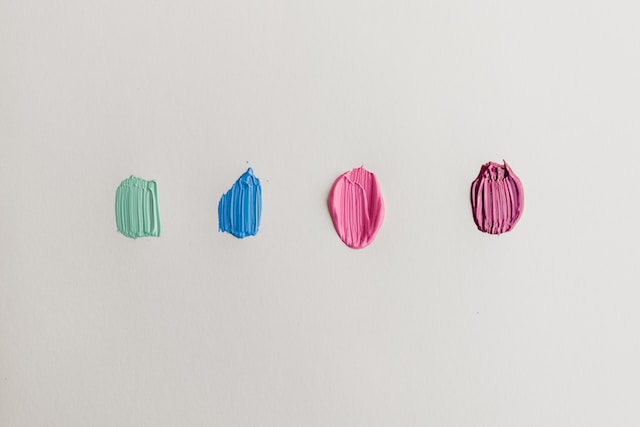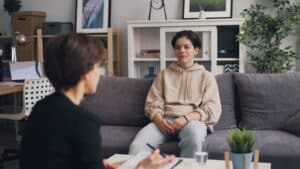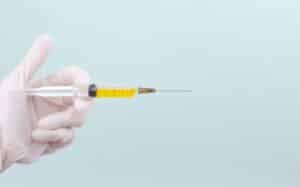Our blog previously discussed the neuroscience of creativity: how creativity can help regulate your nervous system, what flow is and how it works in our brains, and more. You can read all about it here! It is fascinating to understand those processes, but you may wonder how that ties into mental wellness outcomes. Mindfulness in art is one great example!
Mindfulness in Art: How Art Supports a Mindful Headspace
Art is research supported as a method of self-care and stress reduction. We at Best Within You have discussed art as a great tool for self-care between therapy sessions. Art has the potential to foster mindfulness. Mindfulness is the practice of focusing one’s attention and awareness on the present moment free of judgment.
If you were to walk mindfully, you might pay attention to sights, sounds, smells, and physical sensations while walking slowly instead of getting lost in thought. Mindfulness encourages non-judgemental observation of thoughts, emotions, and sensations.
An example of mindfulness might be noticing, describing, and observing the emotion of anxiety, the sensation of shallow breathing, and thoughts related to the experience.
Formal mindfulness meditation is intended to help train your mind to stay present with an attitude of self-compassion. It encourages people not to self-label as bad or defective when they experience difficult thoughts or emotions. Higher levels of mindfulness are related to increased psychological health and decreased negative emotions.
Mindfulness in art is supported by being engaged with the present moment experience through the five senses. One study revealed that the tactile sensations of finger painting facilitated a mindful state; participants reported being more aware and present in the current moment with a broader scope of attention.
It is also hypothesized that mindfulness practices activate overlapping brain networks including the default mode network and the executive control network. A similar phenomenon occurs with creative thought processes, so the two may be related. This allows for more present-focused responses rather than reactivity.
Mindfulness in art is not implied or automatic. Mindful crafting necessitates mindful intentions or instruction. Mindfulness-Based Art Therapy (MBAT) emerged from this idea.
The Intersection of Mindfulness in Art and Art Therapy: Mindfulness-Based Art Therapy (MBAT)
Mindfulness-Based Art Therapy (MBAT) incorporates Mindfulness-Based Stress Reduction (MBSR) -a technique to improve one’s understanding of their self/emotions and approach situations with acceptance and awareness- with the art therapy setting.
Sometimes, the practice is also called “focusing-oriented art therapy,” because MBAT fosters shifts in focus as part of the therapeutic and artistic processes.
MBAT can benefit those struggling with anxiety disorders, eating disorders, substance abuse, depressive disorders, anger-related issues, and more. Often, the mindfulness in art fostered by MBAT helps individuals with physical illnesses that can raise psychological concerns.
Research has shown that MBAT is effective in decreasing psychological stress and increasing spiritual well-being in breast cancer patients undergoing chemotherapy. Reviews of the current literature suggest that MBAT significantly improves psychological and physical symptoms of anxiety, depression, and fatigue.
Some examples of MBAT practices that you can try at home are:
-
- Drawing a self-portrait to exercise self-acceptance
- Studying art materials and noting what you see, feel, touch, hear, and taste.
- Painting, sculpting, or drawing to express emotion and observing resultant physical sensations.
While you cannot self-administer art therapy or MBAT, all art has additional mental health benefits. Art practices as simple as coloring have evident benefits.
A University of Tampa study revealed that coloring reduced perceived stress and psychological distress. This particular study took place during the pandemic, so many participants colored online, which may have minimized the potential positive effects of the sensory experience coloring with paper could elicit. Nonetheless, even online, there were notable benefits.
Additional research studies have confirmed that coloring reduces anxiety. Some studies suggest that any form of coloring is beneficial but creating or coloring mandalas has especially positive effects. Pre-printed mandala coloring has proven to be significantly more anxiety-reducing than free-form coloring.
Circular patterns have more positive effects on mood than square patterns, which may contribute to these findings. Mandalas tend to represent transformation: a powerful concept for expressing oneself through art. The trance-like effect that can result from the structure and repetition of coloring or creating mandalas may be part of its potential anxiety reduction.
You can find some free, printable mandalas to color here.
You can practice mindfulness in art at home and experience art’s proven mental health benefits through crafts and coloring, but it is important to remember that you cannot self-administer art therapy or MBAT.
All art creation does not constitute art therapy! Art therapy has fundamental relational aspects like the psychotherapeutic relationship and the relationship between clients and their art materials and products.
What Distinguishes Art Therapy?
Art therapy was developed on the foundation that art can function as a form of communication, self-expression, group interaction, and even conflict resolution. Art can serve as a medium for the expression of feelings; in many instances, it communicates emotion without words. Talking about experiences and feelings is beneficial; it is one of the premises of therapy.
Sometimes we have feelings and experiences that are difficult for us to express verbally. Art enables the expression of feelings through creative work. This can be especially beneficial for people who feel disconnected from their emotions or for people having difficulty discussing or remembering painful events.
There are a variety of different techniques employed in art therapy including painting, finger painting, sculpting, carving, and more. Hands-on techniques in art therapy, like molding clay, are known as tactile techniques.
Different tactile sensations can elicit different emotional and psychological experiences. Materials, when used in art therapy, are often chosen for various reasons. For example, the use of watercolor paints or chalk pastels might be a medium of choice when working to challenge perfectionism.
Just like the medium, the method of creating art sets the frame for different emotional experiences. Using spontaneous art-making techniques such as scribble drawing or paint/ink blotting is considered nondirective – where the individual is asked to create art forms without a preconceived notion of what they will be creating. Directive art might instruct someone to draw a tree or draw their family.
Nondirective, spontaneous art techniques help people consider what they are seeing and exploring. It can help them process uncensored experiences from a subconscious level (Malchiodi, C. (2006). Art Therapy Sourcebook (2nd ed.). McGraw-Hill Professional.).
Art For Chronic Illness
Illness is closely associated with intense emotions and tactile techniques can help ease and work through those emotions as you work with the piece. This type of activity is effective in revealing unconscious material, cathartic release, and promoting verbal expression.
Color choices, choice of medium, as well as non-directive and directive techniques, are some other choices/techniques that give people ownership over their art therapy experience and foster emotional processing.
One population that art therapy benefits is those suffering from chronic illness. People with anxiety and depression, those suffering from Post-Traumatic Stress Disorder, the elderly, and others may improve with art therapy.
As such, hospitals, veteran’s clinics, schools, crisis centers, residential treatment centers, and senior communities are just some of the places where art therapists might work.
Art therapy serves as a hybrid field between art and psychology. It uses the creative process, pieces of art created in therapy, and third-party artwork to help develop self-awareness, explore emotions, address unresolved emotional conflicts, improve social skills, and raise self-esteem.
One of the best things about art therapy is that no artistic experience or ability is necessary to benefit from it. To learn more about art therapy, check out the American Art Therapy Association website.
Art therapy in Buckhead
Dr. Riss and Dr. Parker are two Buckhead based therapists that provide art therapy. They will integrate art therapy into the therapeutic process as appropriate and as desired by the client. If you are interested in scheduling an appointment with a therapist that uses art in therapy please visit our appointment page.
Thank you to Dr. Riss, licensed psychologist, as well as Mia Pearce and Jane Goldsmith, Best Within You Therapy & Wellness interns, for this blog post.
















